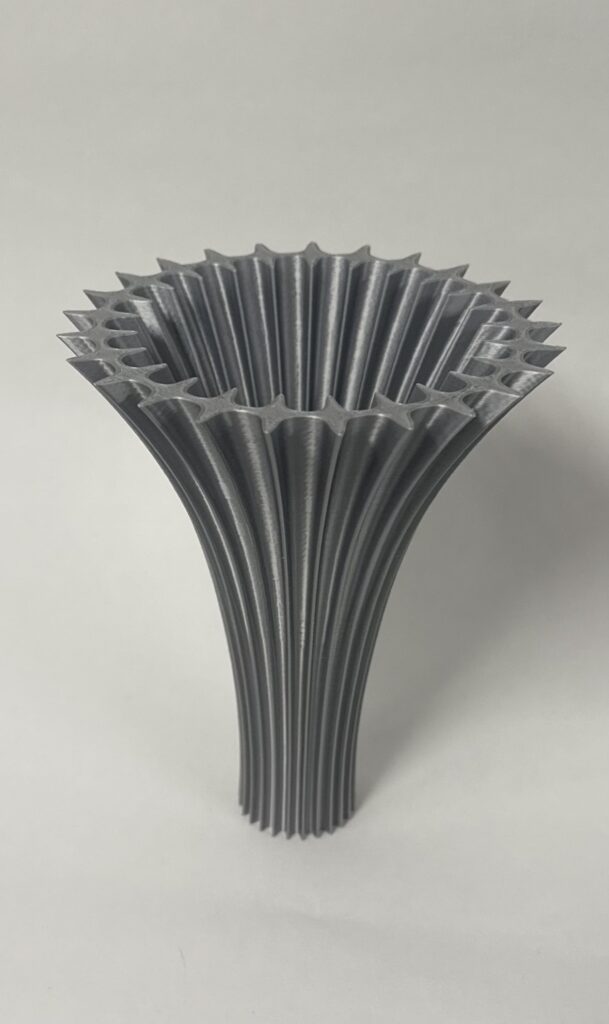Introduction
This project focuses on the manipulation of sound intensity. Increasing and decreasing intensity was our primary objective. Research from past projects along with architectural acoustic simulation software assisted us with our experiment. Our final shapes were printed with PLA, ensuring even wall thickness and similar patterns throughout our designs. These steps were done to ensure consistent testing which increased accuracy results.
During this experiment we tested with two baseline vessels with differing inserts. Each insert serving its own purpose of either amplifying or reducing sound intensity. Although many shapes and structures were considered we stuck with two, a Helmholtz resonator and Radial ribs.
Background Research
https://journals.plos.org/plosone/article?id=10.1371/journal.pone.0258842
https://www.orase.org/pachyderm
Process
Fabrication Challenges
When designing some the Helmholtz resonator array we faces challenges with tiling the plane. We ended up designing a simple honeycomb array like structure, where we used a triangle lattice to connect the honeycomb breps that where strategically designed in rhino. We also face extremely long print times because we printed all of our shapes with 100% infill.
Program Challenges
When generating our shapes and vessels, it was important we didn’t waste print time or filament to get our end result. In order to combat this we researched audio simulation software. In the beginning we used Pyroomacoustics along with Numpy STL. This software only allowed closed area testing without obstruction, which varied our simulation results. After discovering this we decided to use Pachyderm, which is an architectural grasshopper plug in that is able to simulate audio with various material and object configurations. Initially we created our own PLA material within the program and placed transmission and absorption coefficients for each frequency range based on previous research. We were able to get steady energy loss (sound loss) values, but that was our only reliable value. Capitalizing on energy loss we began experimenting with ray tracing. This finds the path of sound waves throughout a structure, and its energy loss per its reflection off a material. Once we got the process figured out we used ray tracing to develop our vessels and infills. It was also how we created the simulation videos.

Fabricated Simulation Outcome
nserted below are pictures of our final product. There are also videos from the audio simulations we ran with Pachyderm
Our overall results were not as we hoped. One of our inserts had the exact opposite effect from what it was intended. From our research and simulations the radial ribs gave us the best opportunity to amplify sound from an internal structure. Instead of intensifying the sound played, it actually muted it more than the Honeycomb Helmholtz resonator. We believe it is due to the surface area and its ability to absorb sound rather than channel it. This is just an assumption, as we ran out of time trying to figure it out.





| Object | Infill | Decibels |
| Pipe | None | 88.2 |
| Horn | None | 96.7 |
| Pipe | HRA Honeycomb | 71.7 |
| Horn | HRA Honeycomb | 84.4 |
| Pipe | Radial Ribs | 69.6 |
| Horn | Radial Ribs | 81.6 |
| Speaker | – | 74.3 |
Future Work
For future implementation and design there are so many routes this project could go down. We have already researched printing these infills in with different materials that have better sound absorbance properties. There are different infill patterns that we can create. One major roadblock was the scale of the object we were creating, and the testing environment.
Reflection
This project was filled with very unique experiences and challenges. Especially in sound simulation and measurement. We explored concepts obtained from the course material such as tiling, parametric design, and toolpath movement. Expanding on these concepts helped create the patterns needed to produce the effects we intended. It was challenging to produce accurate simulations due to the uniqueness of this project. From these challenges and new found knowledge we will be able to take the skills and tools discovered and apply them to any future design.